Having discussed the Triffid-like rhododendrons that infest parts of Ardnamurchan and the tools needed to clear them, here’s a further instalment showing how to ensure they don’t re-grow.
Rhododendron (Rhododendron ponticum) are relatively shallow-rooted woody shrubs. They can spread by wind-dispersed seed and by suckering. Suckers are more correctly termed basal shoots and emerge from the root system.
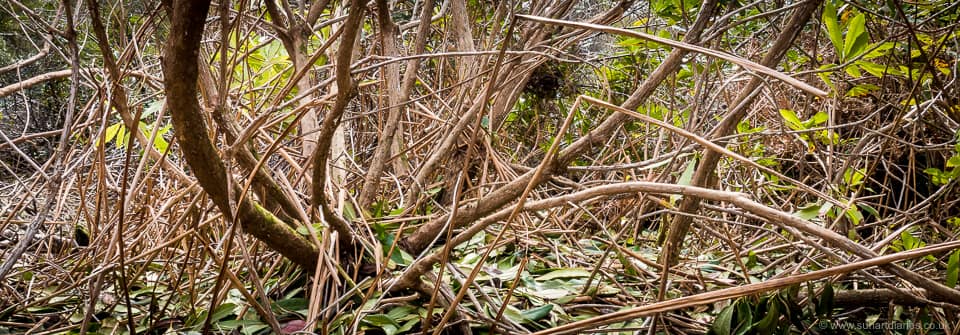
Dense rhododendron growth with no understorey
Each of these suckers essentially has the ability to form a new plant.
If you cut a rhododendron to near ground level - leaving just enough of the woody stump to trip over 😧 - it will usually produce new growth.
Even if it doesn’t produce growth from the stump, it will almost certainly generate suckers from which large new plants will eventually grow.
Consequently, simply cutting rhododendrons to the ground and leaving the roots untouched results in dense multi-stemmed thickets forming.
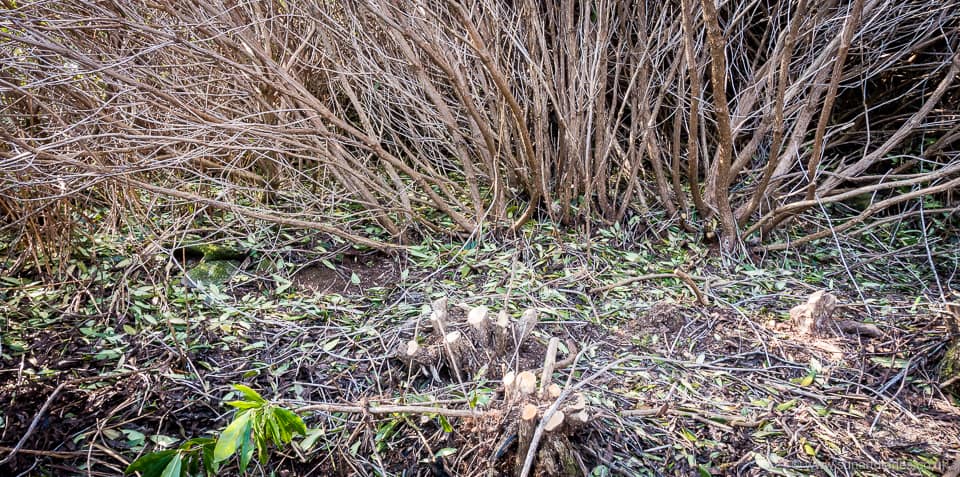
Multi-stemmed rhododendron from suckering
Therefore to ensure the rhododendron does not re-grow you must kill the roots of the plant. There are a variety of methods that can be used to achieve this, some faster than others.
Environmentally friendly methods - efficacy unknown
You can cut and clear the rhododendron and then periodically return to the stumps and, using something like a hammer, smash down the re-growth. Over a period (perhaps a long period) the stump will be killed.
There is an approach called the ’lever and mulch’ method in which the shrub is cut down and the amputated top growth is used to cover the stump, effectively starving any new growth of light.
I’ve not tried either of these methods - I don’t have the time and want the site cleared - and so cannot comment further on them.
Environmentally unfriendly methods
A very common approach is to cut down the plant and then return after it has re-sprouted to spray with a systemic weedkiller such as glyphosate (in commercial products Roundup or Gallup).
Spraying requires a dry relatively calm day. If it’s wet and/or windy the weedkiller will either be less effective or may damage other plants.
Ardnamurchan has fabulous weather but it’s not always suitable for spray treatment 😉
I’m also not keen on the relatively indiscriminate application of weedkillers so have not used this method.
Drill and drop
What’s needed is a method that applies a weedkiller such as concentrated glyphosate in small amounts precisely where it is needed.
This can be easily achieved using stem injection.
The method is simplicity itself. A 10mm hole is drilled near the base of the trunk and 1-2ml of strong weedkiller is applied directly into the hole. The weedkiller is transported throughout the plant and, over a period of weeks or a few months, the plant is killed.
Once the plant is dead it can be cut down and burnt.
For pretty-obvious reasons this method is known as drill and drop.
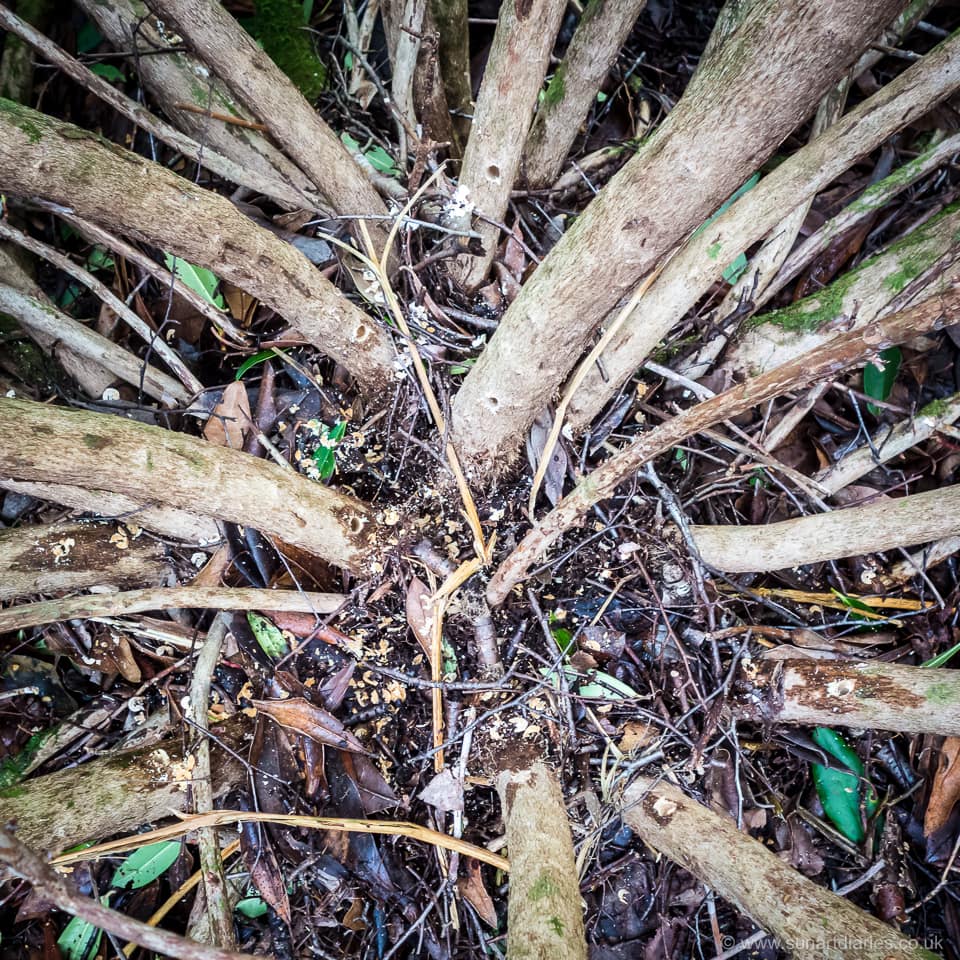
Birds-eye view of a multi-stemmed rhododendron drilled for glyphosate application
Notice the holes an inch or two above the leaf litter in all the major stems. Why, if ’… the weedkiller is transported throughout the plant …’ does every stem have to be drilled?
That’s because I oversimplified the method. The weedkiller appears to only kill the top growth and root of the individual sucker. It’s not entirely clear why. I presume that the new growth establishes its own root system over time (some of these stems are 2-3" in diameter and 15-18 feet long) and that the weedkiller only spreads systemically within this new growth.
Consequently every stem must be drilled … and some will be missed 1.
Therefore, there is another method that can be used …
Drop and drill
You cut the plant down first, drill the remaining stump and apply the weedkiller. This approach has the advantage of immediacy. There’s no waiting for the rhododendron to die. It also has the advantage of thoroughness. Since you’ve cut all the top growth down you cannot inadvertently miss any of the stems.
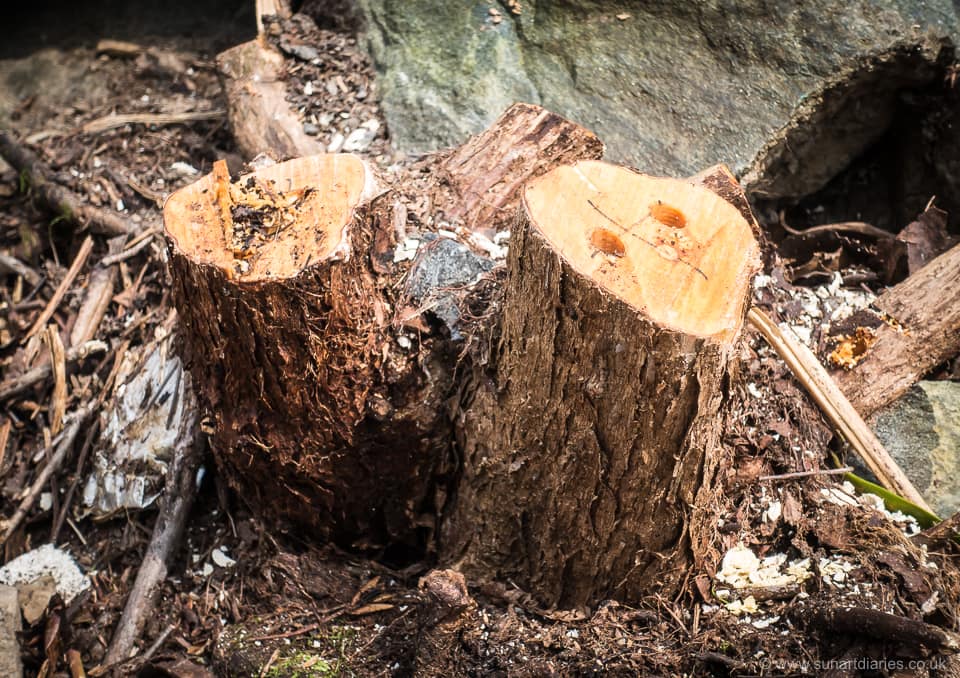
Drop and drill
The additional advantage is that you are generally drilling from the top into the stump. It’s easier to generate a clean hole and there’s even less chance of spilling weedkiller.
Driller killer
A battery-powered portable drill with a 10mm wood bit is needed. If the rhododendron growth is very dense or very extensive or - in my case - very dense and extensive 😧 then it’s worth having a spare charged battery or two so you aren’t forced to stop just as you’re beginning to have fun.
The hole needs to be 2-5 cm deep. It is best drilled at an acute angle to reduce the chance of excess weedkiller running down the stem onto other plants. One hole is generally sufficient, even for the largest stems.
Stems as narrow as 2 cm in diameter can also be drilled. Choose a place where the growth is horizontal - close to the original stump - and drill a 1 cm deep hole, filling it with weedkiller to just below the brim.
Choose your poison
The weedkiller I use is Gallup glyphosate. Bought in bulk this costs about £20 for 2 litres. Because you’re applying a very small amount to a single, potentially very large, plant it needs to be used quite concentrated. I’ve used it at 20-25% i.e. mixed 1 in 4 or 1 in 5 with water.
Prepare a stock solution in a well-labelled plastic bottle. Don’t make up much more than you need as I’ve read it degrades over time and so loses efficacy. I make up 250 ml which is enough for a very rewarding afternoon of rhodo-poisoning.
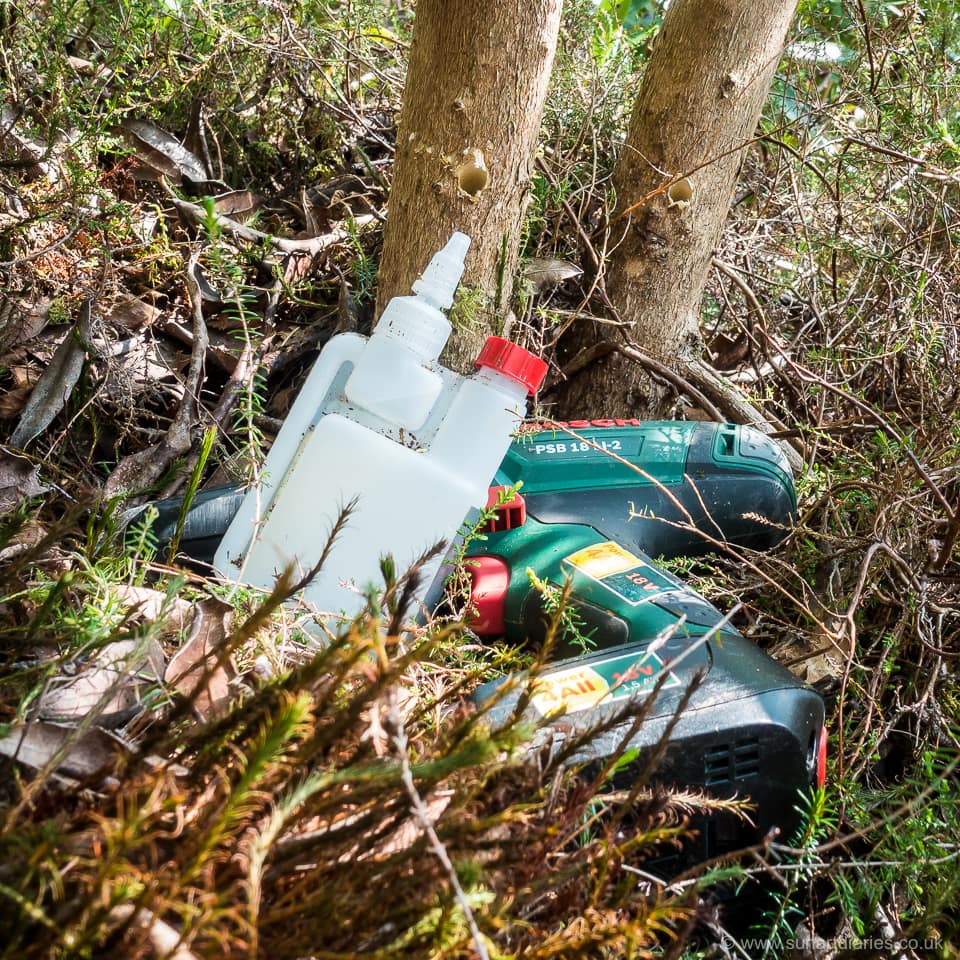
Trickle 2 container for delivery of glyphosate
Administering 1-2 ml to a small hole in the base of a drilled stem requires a steady hand and a bottle with a nozzle that doesn’t drip or leak. I’ve used what a beekeeper would know as a Trickle 2 oxalic acid bottle. These probably have a proper name, but I’ve no idea what it is.
The bottle has a 100 ml reservoir and a small upper chamber that takes 5 ml. It has a twist-lock nozzle and doesn’t drip. It needs to be refilled every 50 or so stems. Remember you’re probably using it on your hands and knees in dense undergrowth. A refill is a welcome opportunity to stand up and stretch.
Drill and drop vs. Drop and drill
In practice I’ve found I have to use a mix of the two approaches. Each has advantages and disadvantages, but both are usually needed.
Drill and drop is great because the killed shrubs are much lighter to cut down, easier to transport and burn faster. It takes about 3 months for the plants to die - the upper growth withers and finally drops off.
The disadvantage of drill and drop is that you need to get to the base of the stems in very heavily-overgrown areas. Almost inevitably this means crawling about, working in confined dingy spaces and involves encounters with brambles, wasps nests and sharp pointy things.
Wear safety glasses.
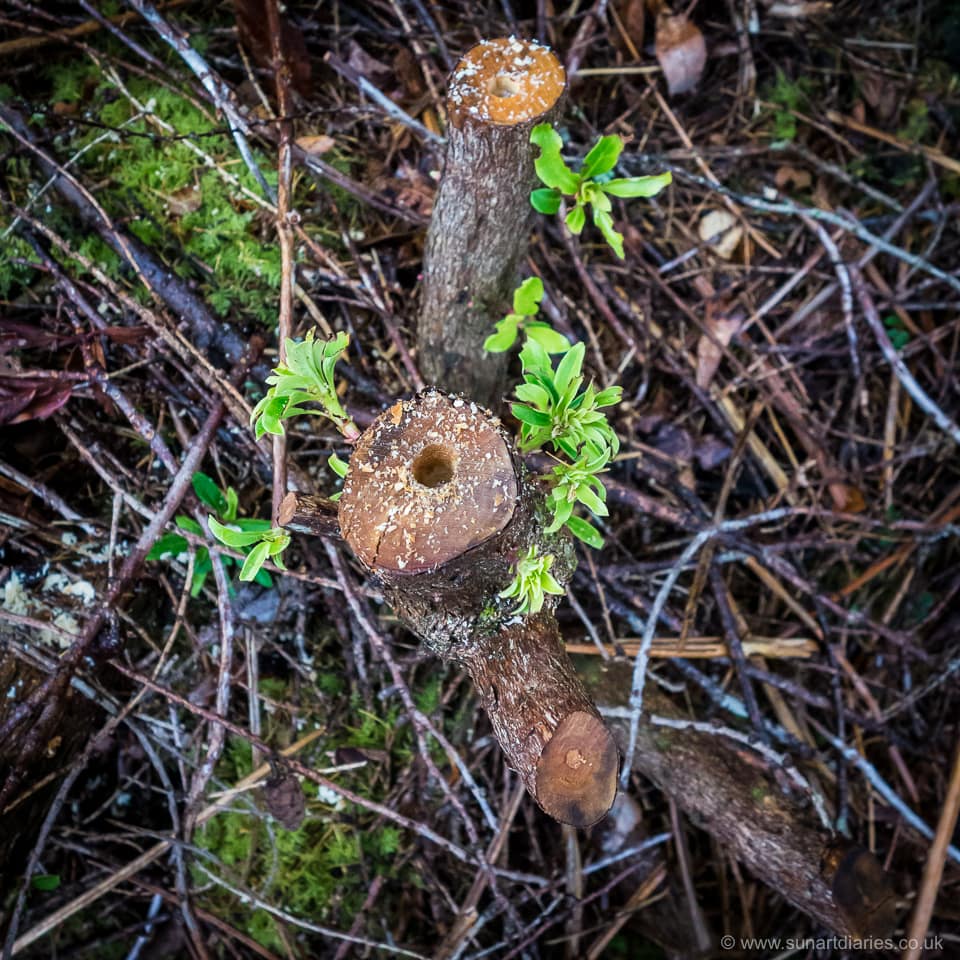
New growth retrospectively drilled and killed
Almost inevitably you’ll miss some stems. Drop and drill has the advantage of immediacy. You cut the plant down and then drill and poison the stump. You gradually work your way through a dense thicket, but the drilling and glyphosate delivery is done in an already cleared area so is much easier.
Slash and burn
I prefer to drill the plants, let them die back, cut them all down and return to ‘mop up’ the remainders I missed the first time round. I usually carry a pen to mark stumps cut down ’live’ that need retrospective treatment 2. This avoids double-dosing.
If you cut the trunk near but below the previously drilled site the woody interior of the stem is usually stained distinctively, so you can avoid re-dosing it.
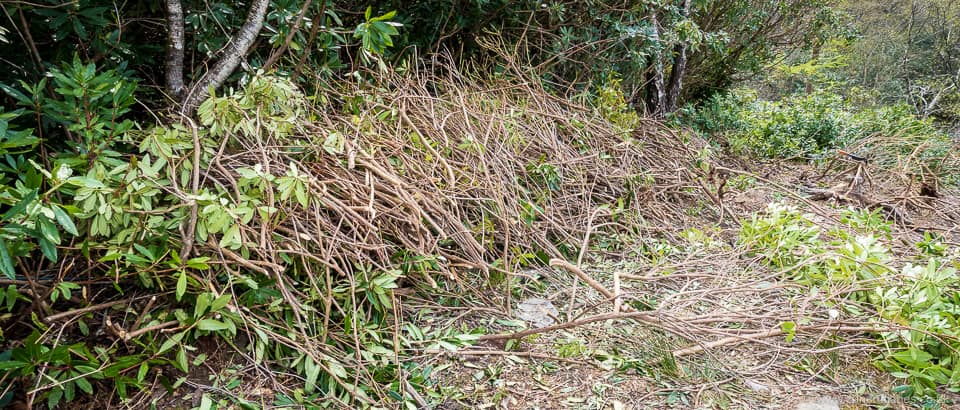
Waiting for the inferno
The side branches and top growth are removed with a billhook, stacked up and subsequently burnt.
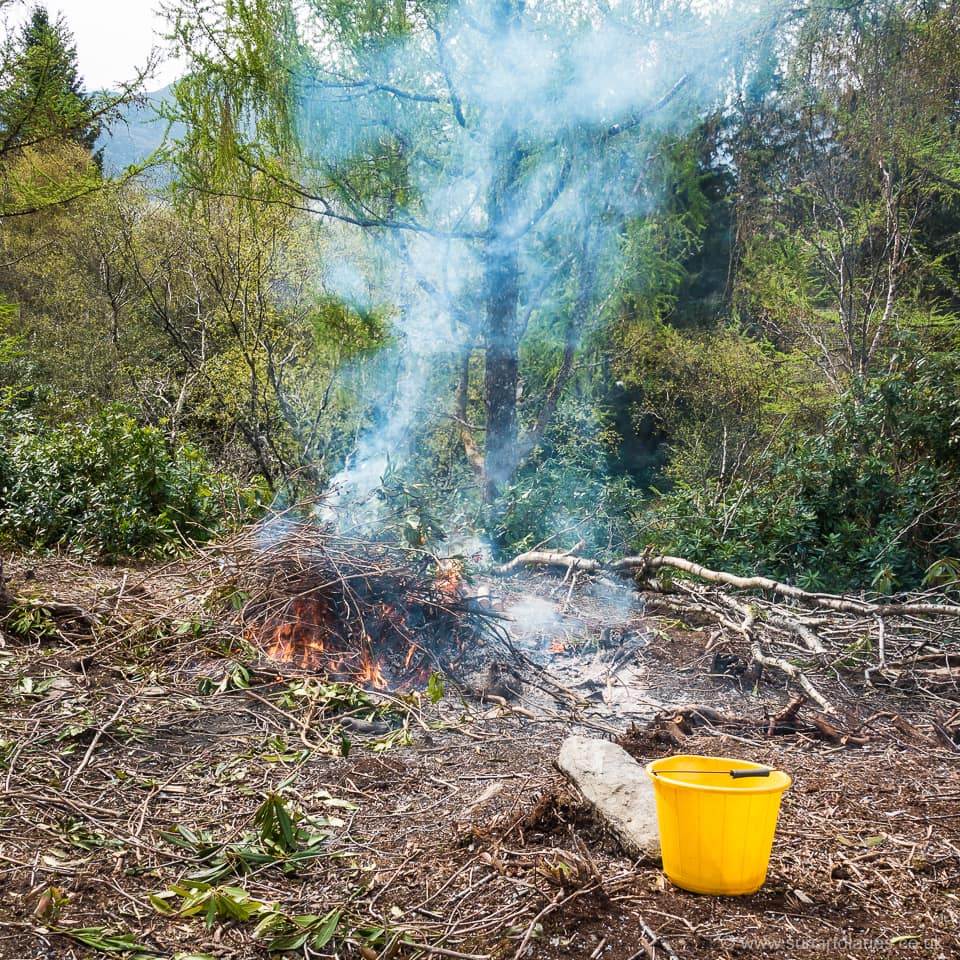
Towering inferno
The main stems are cut up and dried for firewood.
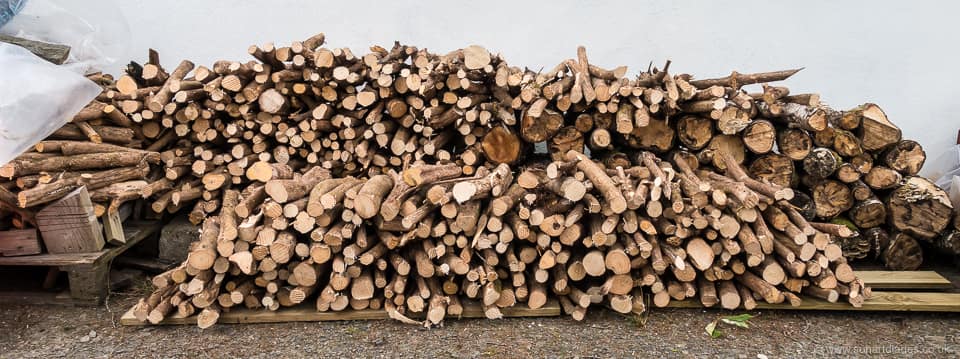
Something for the winter
That lot is about half what I prepared from the 1600 m2 (i.e. 40 m x 40 m) area I’ve cleared so far.
Glyphosate - mode of action and toxicity
Glyphosate is a broad-spectrum (i.e. indiscriminate) weedkiller that inhibits the plant enzyme 5-enolpyruvylshikimate-3-phosphate synthase. This enzyme is critical for the synthesis of the aromatic amino acids tyrosine, tryptophan and phenylalanine. Production of these amino acids is important during plant growth which explains why glyphosate only kills growing plants.
Glyphosate was discovered by Monsanto, given the trade name Roundup and first used for agricultural purposes in 1974.
It is adsorbed through the leaves, through drilled or cut stems but only poorly through the roots. Stem drilling, or stem injection, is a much more effective way of administering glyphosate than simply painting it onto a cut stem; there is less wastage and much less potential for collateral damage.
Glyphosate has low acute toxicity and a half-life of about 47 days in soil.
Glyphosates and cancer
Glyphosate is extremely widely used. Consequently, residual amounts are sometimes found in food products. The levels are very low, with over 99.5% of nearly 7000 food products tested in 2016 having less than the maximum allowed residue levels.
However, the very widespread use and potential long-term exposure to low levels of glyphosate mean that it has repeatedly been associated with causing human cancers. Monsanto (now Bayer) have recently lost a court case when sued by a an individual who had developed non-Hodgkin lymphoma, claiming it was caused by long-term exposure to high levels of glyphosate while working as a gardener. Monsanto is appealing against the decision.
The scientific evidence (a very different level of ‘proof’ to a law court) supporting glyphosate being a carcinogen is very limited and equivocal.
A long-term (decades) study of 55,000 people showed that there was no increased risk of cancer in those exposed to higher levels of glyphosate.
Very recently a meta-analysis (a statistical study of other studies) has linked exposure to very high levels of glyphosate to non-Hodgkin lymphoma. Despite the headline figure being a scary 41% increased risk 3 of developing non-Hodgkin’s lymphoma the absolute risk was only about 0.5%. And this was only for people exposed to very high levels over a very long period.
The headline 41% figure sold some newspapers, but the coverage was probably distorted and ignored or selectively over-interpreted much of the scientific evidence.
There’s was a good account of this subject on the More or Less podcast recently.
Nevertheless, I always take care when using glyphosate. I wear disposable nitrile gloves and safety glasses. I administer small doses (1-2 ml) to the drilled holes, avoid spilling it and wash my tools and hands carefully after use.
A blank canvas
Before
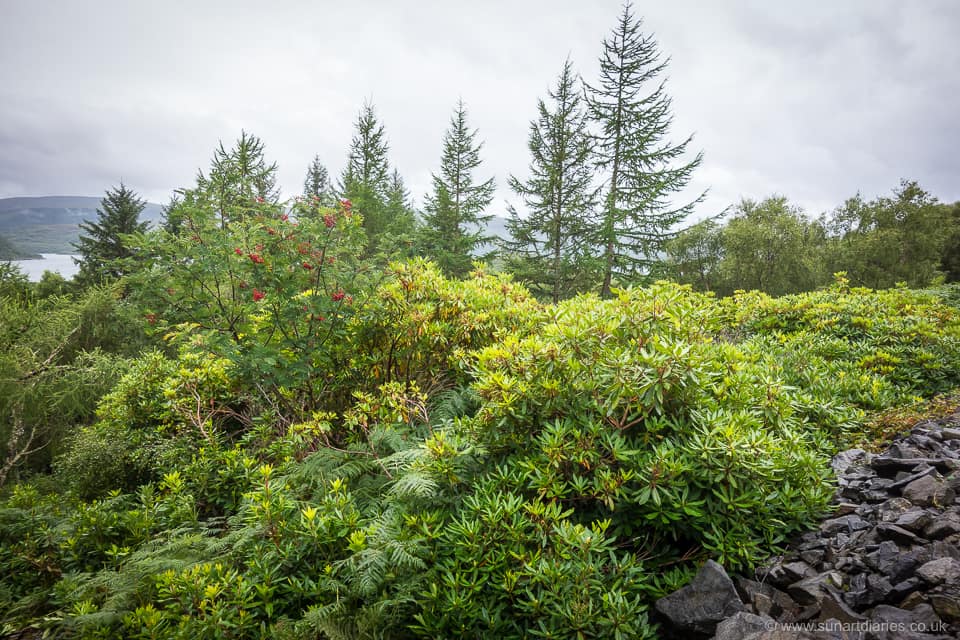
Ardnamurchan or Borneo?
After
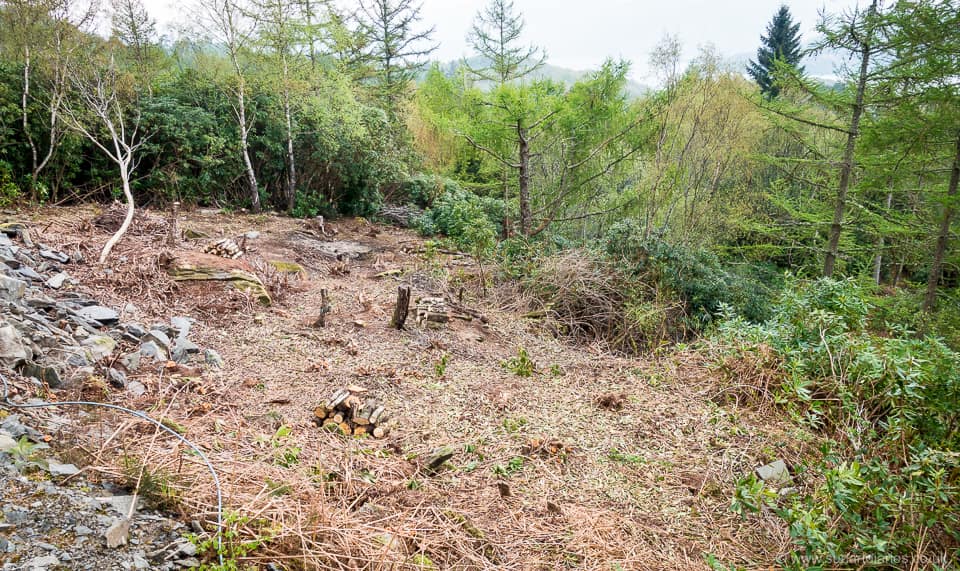
Cleared and ready for native tree planting
There’s still more to do (measured in acres not m2) but after a bit more clearing this area will be planted up with native trees in the 2019/20 winter. —
-
I have tried to burrow down to the original stump, drilled that and applied weedkiller … it doesn’t work often enough to be worthwhile. The original stump is often rotten and you miss the new root growth. ↩︎
-
Often there will be some missed from multiple stems arising from a single original stump. ↩︎
-
Let’s put some numbers here … non-Hodgkin lymphoma is diagnosed in ~ 27 people per 100,000 of the UK population per year (about ten-times the road death rate). A 41% increase is ~11 more cases per year per 100,000 people. ↩︎